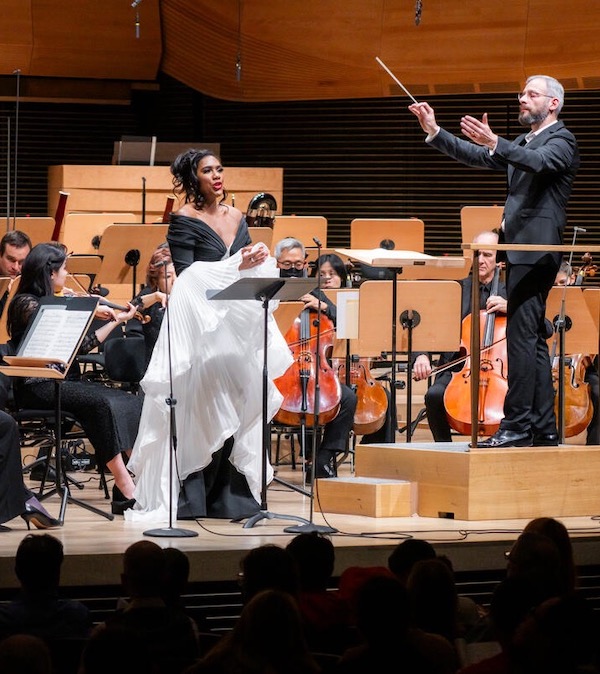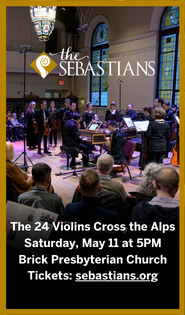Worlds collide, as Ligeti and Holst rule at NY Philharmonic

In the span of about ten minutes, the New York Philharmonic demonstrated the profound difference between live performance and listening to a recording at home. To conclude this fall’s sequence of concerts honoring György Ligeti’s centennial, the orchestra opened Wednesday night’s program at David Geffen Hall with Atmosphères, and for those few minutes what was happening in the hall stood outside the universe as a whole.
Written for large orchestra, Atmosphères opened a night that closed with another work for large orchestra, Gustav Holst’s The Planets. In between was another notable performance, Julia Perry’s Stabat mater, sung by mezzo-soprano J’Nai Bridges. But it was Atmosphères, especially, and The Planets, and the orchestra’s relationship with those pieces and the hall itself, that marked the evening, led by guest conductor Dima Slobodeniouk.
Ligeti’s piece is famous because Stanley Kubrick used it, without permission, for the soundtrack of 2001: A Space Odyssey, and the composer himself is one of the most consequential of our time. That there have been fewer performances of his music in New York than that of William Byrd (this is his 400th anniversary) is one of the insoluble mysteries of institutional thinking. Ligeti changed music, and Atmosphères, not performed by the Philhamornic since 1978, was part of that.
From the composer’s “clocks and clouds” period, the music uses an enormous orchestra to make some of the quietest sounds one will hear in a concert hall. These were impressions from Ligeti’s mind, dreams of interior spaces filled with drifting cobwebs. There was gripping drama in hearing the orchestra build sound, organically, out of nothing; Slobodeniouk’s flowing, careful conducting provided focus and delicacy. Clusters of timbres and dissonances were like spun-glass fibers, glistening and treated with the lightest touch. Instead of a feeling of marking time, the orchestra’s playing had the sensation of a breathing exercise, something designed to deliberately step out of time.
This is an infrequent and marvelous experience in the concert hall, and for this piece, it could only have happened live, the audience having nothing but the music in front of them. The super-refined playing also meant hearing it in a way that can only happen in person, the feeling of enormous presence in a sound that is molto pianissimo.
After this, Stabat mater unfortunately came off as an oddity. Perry is the first black woman composer ever performed by the Philharmonic, and this was the orchestra’s premiere performance of her 1951 piece. This and the quality of the music deserved a better context.
Perry’s writing is deeply skillful mid-century American modernism, gripping emotional expression wrapped in rich, complex tonal harmonies. One is used to hearing Bridges at the Metropolitan Opera; Stabat mater puts the voice in front, often with little or no accompaniment. She was superb with a fantastic sound, a gorgeous and compelling mix of texture and power. Her energy was high, and there was strength from the orchestra behind her.
Still, after Atmosphères, the plain structure of Stabat mater felt stiff and stodgy. The music mostly laid itself out in two and four-bar segments, set one after the other, and the music came off as old-fashioned. Perry deserves to be heard with peers like William Schuman and Samuel Barber.
One wished for the scintillating possibilities of a direct segue from Ligeti to Holst. Though drastically different in style, The Planets shares the values of exploring the possibilities of sound from a large orchestra, and also has much of the same sensual pleasure.
This was a powerful, often thrilling performance, with Slobodeniouk assuredly guiding all the enormous changes in volume, energy, and mood. The Philharmonic didn’t just power through this warhorse, but played with superb musicality throughout. One measure was that while one expected the audience to applaud individual movements, they were silent after the popular “Mars” and instead first showed their appreciation for the glowing playing of “Venus.”
The Philharmonic seems to have found both measure and details of the new acoustic in the remade hall—this was not only loud in a fun way, but one felt a strong physical presence from the music, which added to the excitement. The fanfare and English anthem of “Jupiter” were wonderful, and while “Saturn” could have used a touch more atmosphere, “Uranus” was right at the edge of control. The blend with the off-stage Dessoff Choirs in “Neptune” was perfect, and in the end, their voices didn’t just drift off into quiet, but seemed to float away in space.
This program will be repeated 8 p.m. Friday and Saturday. nyphil.org








Posted Dec 04, 2023 at 9:13 pm by Tom Davey
A perceptive review. I was at this concert. Already a brilliant work, “Atmospheres,” when heard live (a first for me), is indeed even more impressive and effective. Kudos to the NY Phil, which played with complete conviction.